The Air We Breathe
Air pollution affects everyone though the degree may matter
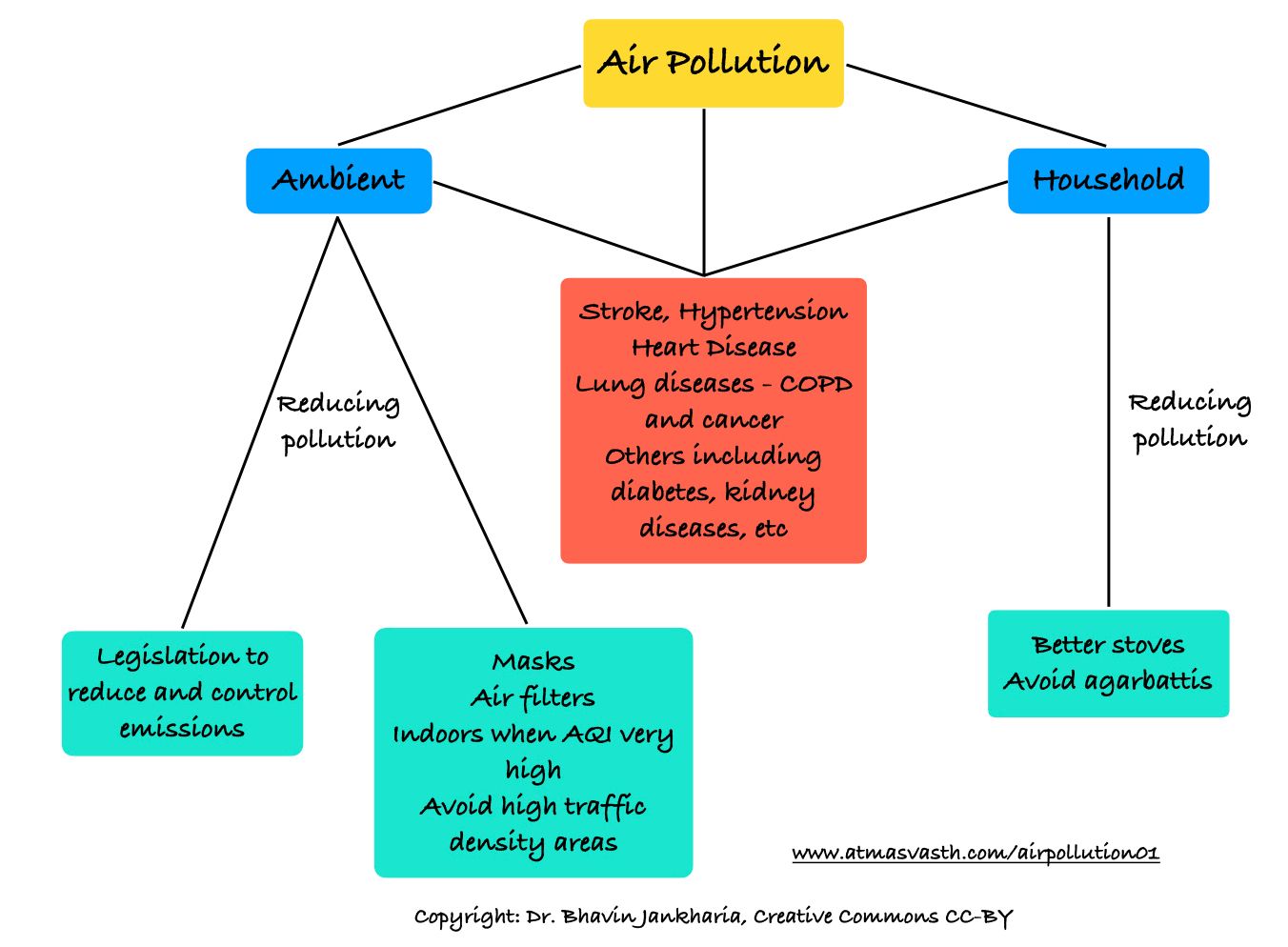
There's so much pollution in the air now that if it weren't for our lungs there'd be no place to put it all. Robert Orben
Pollution in any form, whether it is the air we breathe or the noise around us or the water we drink or the heavy metals that seep into our bodies, reduces our healthspan and lifespan.
Each day, the papers bombard us with news, usually bad, about the air we breathe, the pollution in our cities, the air quality around us (many newspapers carry the AQI of the previous day), the health problems due to poor air quality and so on. As a result, most newspaper readers have some understanding that the air we breathe is polluted and is bad for our health.
But what does this all really mean?
1. What do we mean by air pollution?
There are two ways of defining air pollution. One is subjective, where we can actually see and/or smell the polluted air…dirty, dark, grey, sooty air that smells, air that makes us gag when we breathe or makes us want to instantly cover our noses and mouths, fog that becomes smog with different shades of gray, smoke belching out from cars and trucks and wafting from people burning rubbish on the roads or agarbattis in full flow in enclosed rooms in temples or during poojas and weddings, or the smoke in our houses from cooking on stoves that use coal or kerosene or cow-dung. Our bodies and minds intuitively know when the air we breathe is bad. We understand the invigorating difference instinctively when we go to the mountains or beaches that have cleaner air.
The other way is to objectively measure and define the presence and extent of air pollution.
2. How do we measure air pollution?
Air pollution is divided into ambient air pollution and household air pollution. Ambient air pollution is defined as “exposure to fine particulate matter with an aerodynamic diameter of 2·5 μm or less (PM2.5) in a cubic meter of air (μg/m3)”. [1]. PM means particulate matter. The larger particles (PM10) can enter the lungs and cause respiratory problems, but the smaller (PM2.5) particles have the ability to cross the lungs and enter the blood-stream and directly affect other organs like the heart, kidneys, brains, etc.
The impact of the particle size is better understood as an Air Quality Index (AQI), which is the composite of multiple parameters such as PM2.5, PM10 , ozone, etc. The AQI scale varies from country to country.
Household air pollution at a population level is determined from surveys that look at the extent of solid fuel use in households and then convert these to PM2.5 equivalents. For us as individuals, any smoke in the house, whether from cooking fuel or agarbattis constitutes indoor/household air pollution.
3. What values suggest air pollution?
The WHO values, updated on 22nd Sept 2021 are quite clear and simple. PM2.5 exposure should be less than a mean of 5 µg/m3 annually, with a 24-hour mean of less than 15 µg/m3. The WHO also has published similar values for ozone, sulphur dioxide and nitrogen dioxide. According to the WHO, 99% of the world’s population lives in areas that do not meet these criteria, which means that its current values are aspirational numbers that countries have to strive to reach over a period of time.
India last revised its numbers in 2009. The National Ambient Air Quality Standards are much more liberal allowing for a PM2.5 of 60 µg/m3 annually with a 24-hours mean of less than 40 µg/m3. India is also planning to revise its numbers this year sometime and it will likely be close to but not at the WHO levels.
The AQI is a color coded scale that gives a composite at a specific time point, of the air quality in your area. For e.g. at the time of writing this, the AQI for PM2.5 in Sion (a central suburb of Mumbai) was 57, labeled moderate air quality, corresponding to a PM2.5 level of 31-60, which is supposed to normal for Mumbai, but much higher than what the WHO considers normal.
In fact, if you just Google “air quality index mumbai” you get the current AQI at different stations in the city. The same is true for major cities and towns across the world.
4. What is the extent of air pollution in India?
The 2018 paper [1] published by the India State-Level Disease Burden Initiative Air Pollution Collaborators estimates that 76.8% of India’s population in 2017 was exposed to a PM2.5 of > 40 µg/m3, more in North India (up to 125 µg/m3) than in other states. Only Kerala has a PM2.5 of less than 20 µg/m3 while Karnataka, Goa, Andhra Pradesh, Tamil Nadu, Himachal Pradesh, Arunachal Pradesh, Mizoram and Meghalaya have PM2.5 values between 20-39.9 µg/m3 annually. There are variations with states and within cities (e.g. Mazgaon is more polluted than Worli in Mumbai), but the AQI does help us understand what we are exposed to based on where we live.
Basically, if you are an urban Indian, the more North the city or state you live in, the more you are in trouble.
5. How does air pollution affect our health?
There is good data linking air pollution to increased incidence of stroke (brain attack), coronary and ischemic heart disease, both acute (heart attacks) and chronic, hypertension [2], chronic obstructive pulmonary disease also called COPD, lung cancer, pneumonia and cataract. There is suggestive evidence that links air pollution to poorer pregnancy outcomes, diabetes, kidney diseases, other cancers, dementia and cognitive impairment. The more the air pollution, the more the incidence of premature deaths and morbidity.
6. How big is the health problem?
According to the WHO, 8 million (80 lakh) deaths per year occur due to air pollution globally, 4.2 million due to ambient air pollution and 3.8 million due to household pollution. In India, 1.67 million deaths (16.8 lakh deaths) likely occurred due to air pollution in 2019, (0.98 million or 9.8 lakhs from ambient air pollution and 0.61 million or 6.1 lakhs from household air pollution) [3]. Deaths due to air pollution account for 17.8% of all deaths in India.
As a single risk factor, it is the leading cause of deaths in our country.
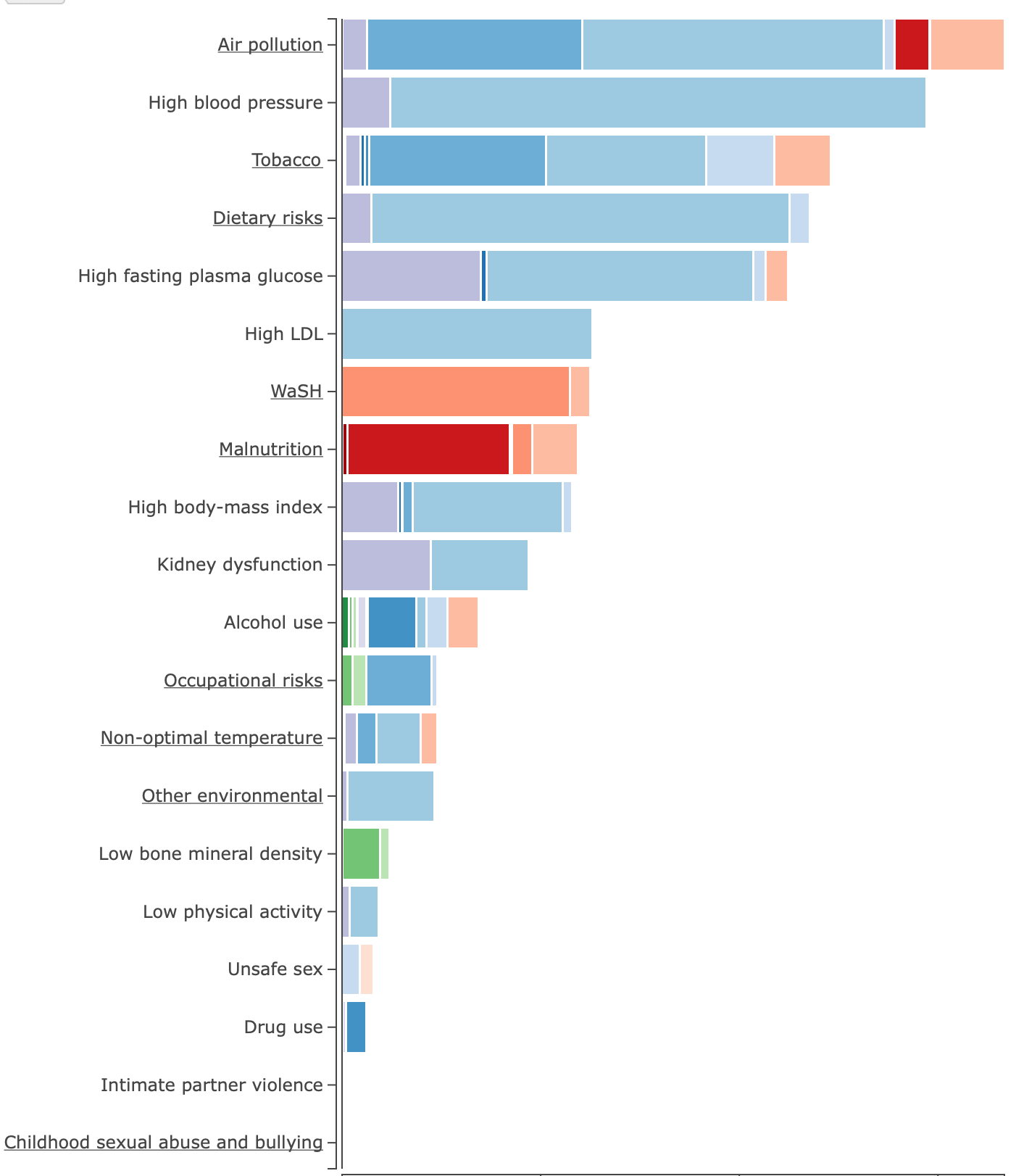
The cost to the country of these premature deaths is 28.8 billion USD or 214330 crore rupees. One third of the healthcare expenditure in this country can be attributed to air pollution, which means at a nationwide level, bring down air pollution can significantly improve our growth and the allocation of resources.
7. What is being done to reduce air pollution?
For ambient air pollution, legislative and non-legislative measures are constantly being updated and enforced, ranging from industrial (e.g. emission standards for factories) to agricultural (not burning crop stubble), to vehicular (low emissions, electric cars, more public transport). All of these help to some extent or the other [4].
For household air pollution, education and replacing stoves that use kerosene, biomass (wood, animal dung, crop waste) and coal with cleaner stoves make a huge difference.
8. What can we as individuals do to reduce the impact of air pollution on our health?
These can be divided into two main categories; reducing pollutants and reducing risk [5].
Reducing pollutants means not using stoves with fuel that produce smoke and not using incense sticks (agarbattis) in enclosed rooms. At an environmental level, it would also mean moving eventually to electric cars.
Reducing risk can be further divided into measures that we take based on the pollution levels on that day versus permanent measures. Permanent measures include the use of appropriate air filters in our offices and homes, efficient air conditioning in our homes and in our cars with our windows up when traveling within the city. Variable measures depend upon the AQI at that time. If the AQI is high, then wearing a mask, reducing outdoor movement including running, walking and other physical activity, choosing a less polluted car route, even it takes a little longer, can make a difference. Even if the AQI is within acceptable limits, it is a good idea to avoid high density traffic if it is possible, and try and walk and run on smaller roads with lesser traffic and preferably in the mornings.
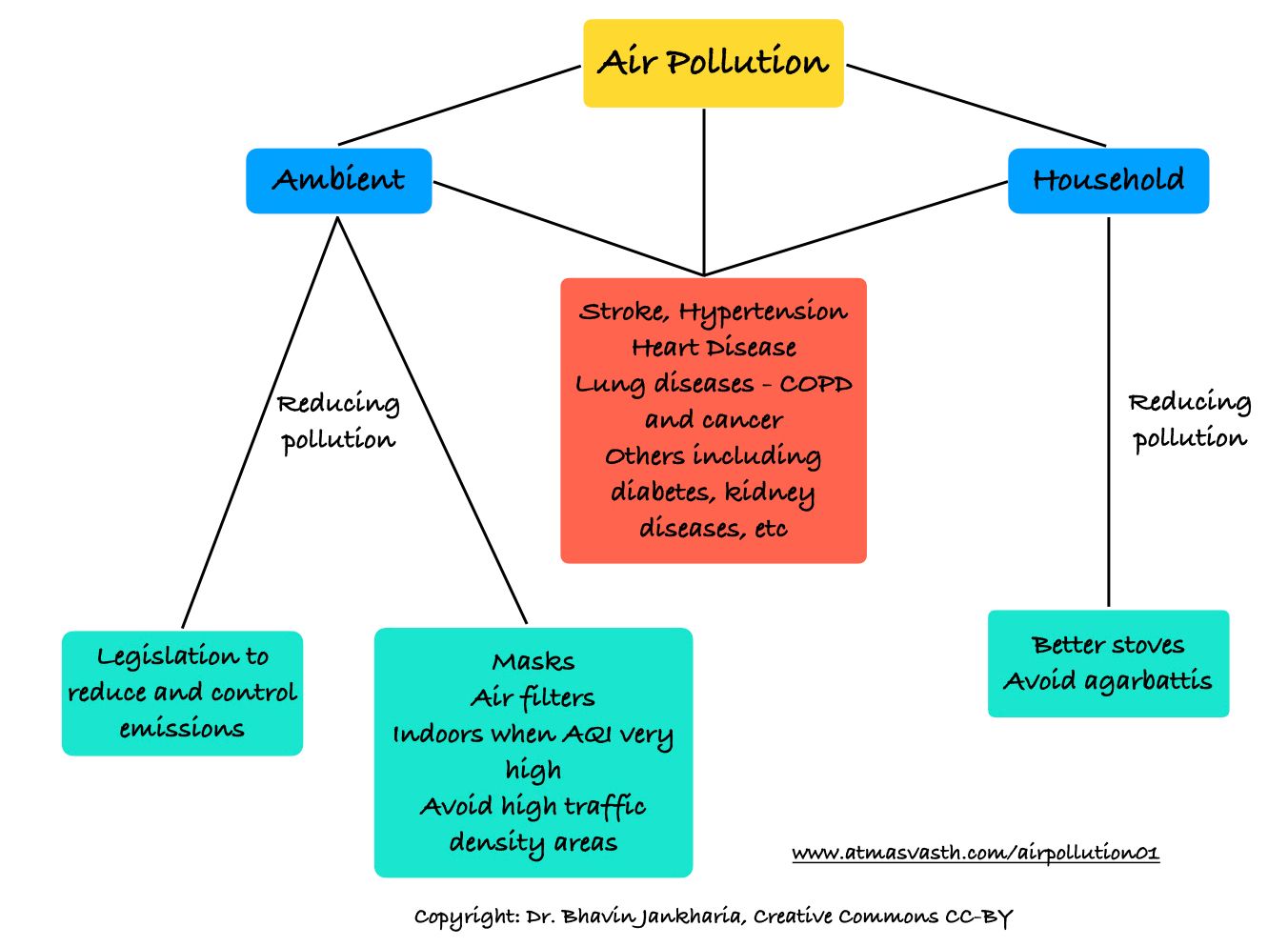
However, whatever we do, in the end, we still land up breathing the same air though what you have and where you live make a difference even in the same city. The rich can reduce their risk far more than the poor as this New York Times piece comparing two Delhi children showed. Our healthspan is the sum total of all the factors, external and internal, that go into keeping us healthy; though we have pretty much no control as individuals on ambient air pollution and are completely dependent on the Government and its agencies to improve the quality of the air we breathe, at an individual level, we can implement measures at home and in our offices to improve the quality of the air we breathe. Thankfully, like with noise pollution, since poor air quality affects all of us, including our politicians and leaders, there are conscious efforts at multiple levels to improve our air quality as much as is economically and politically possible.
Footnotes
1. India State-Level Disease Burden Initiative Air Pollution Collaborators. The impact of air pollution on deaths, disease burden, and life expectancy across the states of India: the Global Burden of Disease Study 2017. Lancet Planet Health. 2019 Jan;3(1):e26-e39.
2. Rajagopalan S, Landrigan PJ. Pollution and the Heart. N Engl J Med. 2021 Nov 11;385(20):1881-1892.
3. India State-Level Disease Burden Initiative Air Pollution Collaborators. Health and economic impact of air pollution in the states of India: the Global Burden of Disease Study 2019. Lancet Planet Health. 2021 Jan;5(1):e25-e38.
4. Burns J et al. Interventions to reduce ambient air pollution and their effects on health: An abridged Cochrane systematic review. Environ Int. 2020 Feb;135:105400.
5. Carlsten C et al. Personal strategies to minimise effects of air pollution on respiratory health: advice for providers, patients and the public. Eur Respir J. 2020 Jun 4;55(6):1902056
Last Week
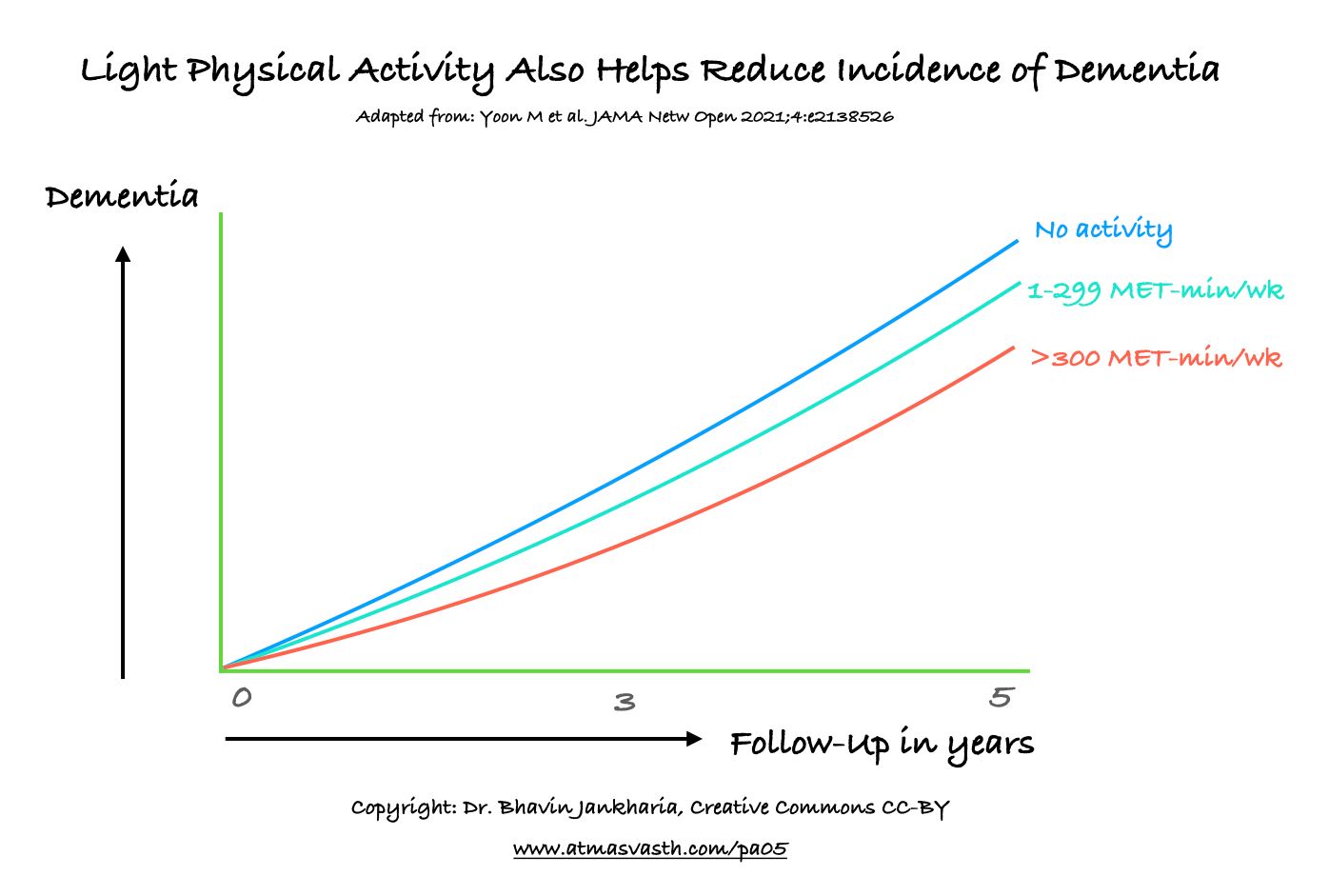
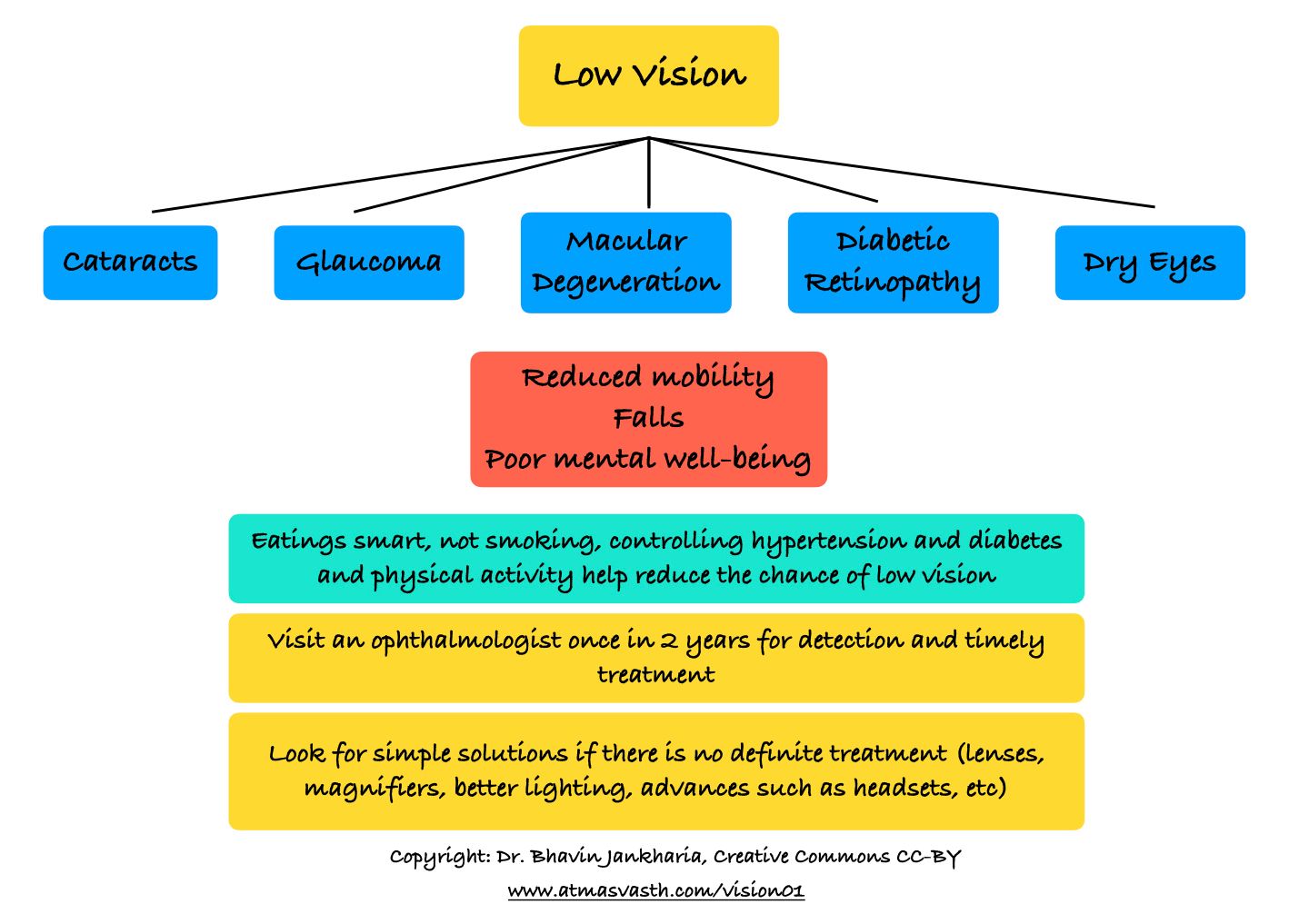
Atmasvasth Newsletter
Join the newsletter to receive the latest updates in your inbox.



